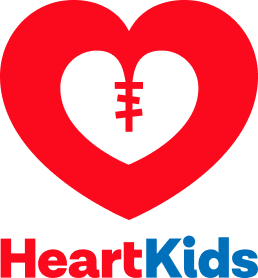Finding out that your child or unborn baby has a heart condition can be an overwhelming experience for parents and carers, which is why it’s okay to reach out for support when you need it. Remember that you are not alone in this journey. There are many support networks available to assist when needed, including your healthcare team and HeartKids support workers. In this article, we’ll explore strategies for navigating a new diagnosis.
How is Childhood Heart Disease Diagnosed?
Childhood heart diseases can be diagnosed at different stages of life. In most cases, congenital heart defects are detected before birth, during an ultrasound scan in pregnancy. In other cases, the heart condition may be identified soon after the baby is born. Some cases of CHD are not diagnosed until later in childhood or in rarer cases, in adulthood. Childhood heart diseases can also be acquired and develop during early life due to an illness or infection – including Rheumatic heart disease and Kawasaki disease.
Treatment For Children With CHD
While there is no cure for CHD, treatment options have continued to improve drastically over the past 60 years. This means that many diagnosed children will lead long and normal lives. In fact, there are presently more adults than children living with CHD in Australia today. Some conditions require no treatment, while others may need regular medication or multiple surgeries. It’s important to consider that every person’s CHD journey will differ, and their care teams will determine the best course of action based on individual needs.
Common Feelings After A Diagnosis
A new CHD diagnosis can bring about a range of emotions for parents and families. Feeling a sense of shock, denial, anger, sadness, and detachment is entirely normal. Each person experiences these emotions differently, and it’s okay to take your time when processing this news. Having supported hundreds of families living with CHD, we understand the emotional challenges that can emerge and are more than happy to assist in navigating your journey at your own pace.
Why Did This Happen To Us?
One of the most common questions parents ask is, “Why did this happen to us?” It’s essential to acknowledge that congenital heart defects are among the most prevalent birth defects, affecting 1 in 100 babies. Moreover, most cases of congenital heart disease have no known cause. Parents should not blame themselves, as these conditions often occur due to factors beyond anyone’s control.
What Comes Next?
The period after diagnosis can seem daunting, as there can be a lot of information to take in. One of the primary things to consider is your first cardiology appointment. From here, you can get a better understanding and feel more confident about what the future may hold. Before and during your first appointment you may want to consider:
- Taking a loved one who can offer support at the appointment.
- Connecting with the social work team for extra support.
- Taking notes during the discussion, such as any critical information and the details of the professionals.
- Asking for information that you can take home and refer to when needed.
- Writing down any questions that may arise to bring to future appointments.
How HeartKids Can Support You
Learning that your child has a heart defect can be a life-changing moment filled with mixed emotions. That’s why it’s important to remember that you don’t have to face this new part of your life alone. No matter where you are or how far you are into your CHD journey, HeartKids is here to support you. Read our fact sheet for more information on how to manage a recent CHD diagnosis, and get in touch with us today for parent-specific support services
References
- KHAIRY, P., IONESCU-ITTU, R., MACKIE, A. S., ABRAHAMOWICZ, M., PILOTE, L. & MARELLI, A. (2010). “Changing mortality in congenital heart disease.” Journal of the American College of Cardiology. 56: 1149- 1157.
- VAN DER LINDE, D., KONINGS, E., SLAGER, M., WITSENBURG, M., HELBING, W., TAKKENBERG, and J. J. & ROOS-HESSELINK (2011). “Birth prevalence of congenital heart disease world-wide: a systematic review and meta-analysis.” Journal of the American College of Cardiology. 58: 2241-2247.
This blog uses information from a fact sheet that was reviewed and updated by HeartKids in March 2021. It was endorsed by our Clinical Advisory Committee at the time of publication. Clinical information might change after this date. The information in this fact sheet is general. It is not a substitute for medical advice from your doctor. Always talk to your doctor about matters that affect your health.



